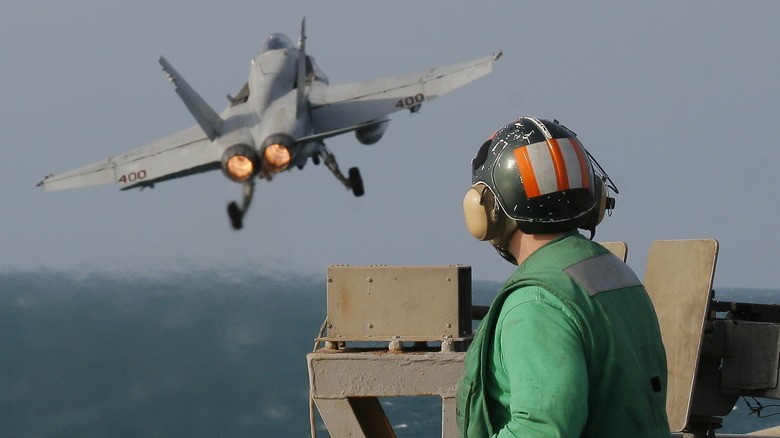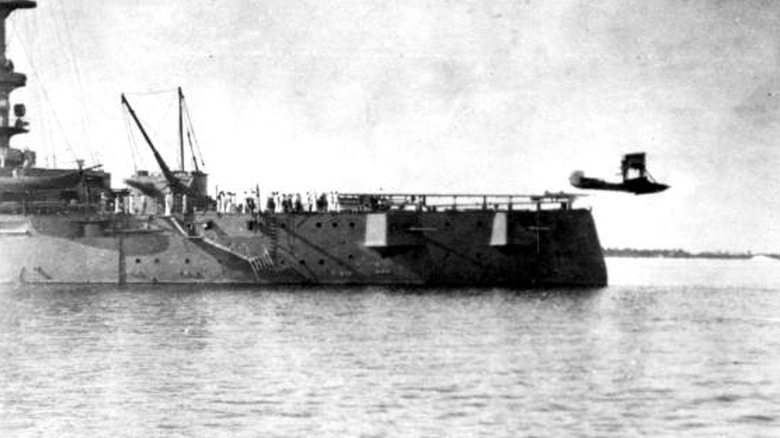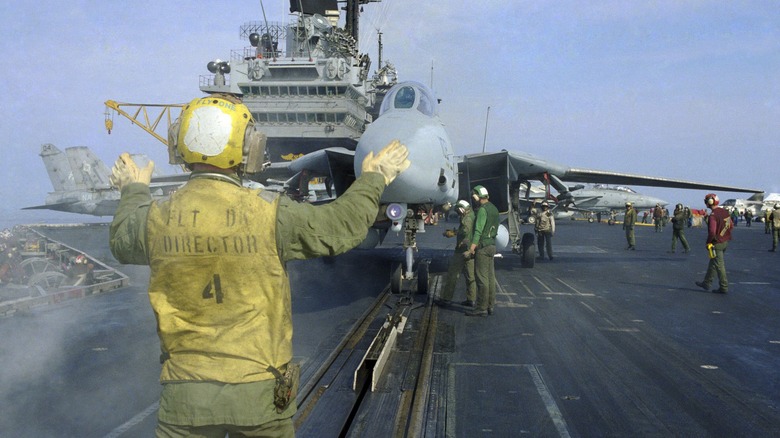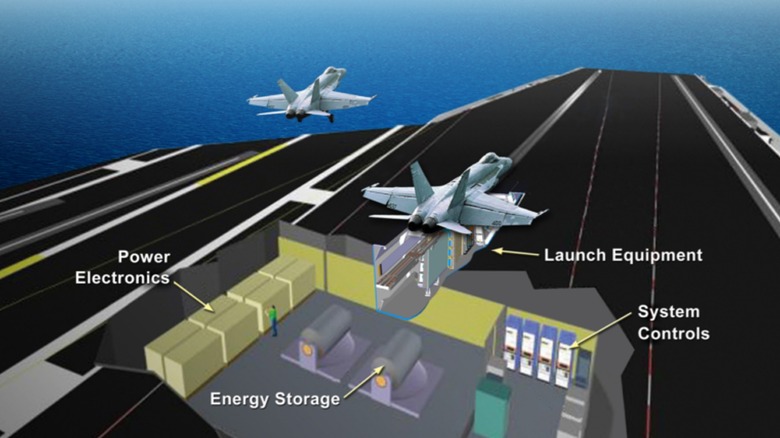How Does An Aircraft Carrier Catapult Work And How Fast Can It Go?
Aircraft carriers are impressive military machines capable of launching aircraft off an incredibly short runway. This isn't done merely by utilizing a fighter jet's speed. Instead, it's accomplished by something most people likely don't consider when thinking about how an aircraft carrier operates. Carriers use catapults to launch aircraft off the deck and into the sky, but the technology behind that isn't what you might expect.
There's no counterweight system flinging fighters into the sky like a boulder upon a medieval battlefield. A modern catapult system used on an aircraft carrier is very different from its ancient namesake, and they're impressive feats of engineering. Since the first ships began launching planes before the outbreak of World War I, catapults were used, and as aircraft advanced technologically, the need for more powerful catapults required further development.
These days, a modern aircraft carrier can employ a variety of catapults to fling aircraft off its deck, and the technology continues to change with time. The more advanced a catapult system is, the more planes can be launched from a carrier, so it's important to keep the catapult launching systems up to date and operational, as they can make or break the combat effectiveness of an entire aircraft carrier.
How aircraft catapult launch systems developed
The first catapult launch system was installed on a stationary coal barge, which shot a biplane on Nov. 12, 1912, but the test ended with a crash the pilot fortunately walked away from. On November 5, 1915, a new catapult system was installed on the USS North Carolina. It proved the concept on a ship underway by speeding an aircraft up to 50 mph before it left the deck, giving it sufficient speed to gain altitude and prove the concept (pictured).
The technology continued to advance, and various attempts were made at safely increasing an aircraft's launch speed. After World War II, the British invented steam catapults and eventually perfected them. These systems used steam from the ship's boilers to launch more powerful and highly advanced jet fighters into the air. This technology is still in use today by numerous navies, though the United States and other nations are moving beyond steam catapults in their newer vessels.
The USS Gerald R. Ford, which is the first in a new class of aircraft carrier, uses an electromagnetic catapult system, which eliminates the need for a steam boiler. Electromagnetic Aircraft Launch Systems, or EMALS, put less stress on the aircraft itself and require less maintenance than older systems, making them ideal for the next generation of nuclear-powered aircraft carriers in and outside of the U.S. Navy.
[Featured image by Usn2012 via Wikimedia Commons | Cropped and scaled | CC BY-SA 3.0]
How an aircraft catapult works
While different types of aircraft catapults have been installed on aircraft carriers, they function in much the same way. The system is designed to shove an airplane off the deck of a ship at a speed that's high enough for it to take flight independently. Early versions could shoot a propeller-driven aircraft at speeds of around 50 mph, but that doesn't work for modern aircraft.
To get something like an F-35C into the air off a short runway, greater speeds are required, hence, the upgrade to electromagnetic launch systems. An aircraft is placed on a track that's built into the flight deck. Below this is a piston or moving part like a shuttle that is situated behind the nose gear of the aircraft. The catapult system is then engaged, moving the piston at a high rate of speed as it carries the aircraft along for the ride.
The jet's engines are simultaneously engaged, and once the piston reaches its maximum speed, it flings the vehicle off the carrier. If everything works correctly, the aircraft speeds off into the sky. This same principle has been used with some variations for more than a century, though some older designs employed wire ropes called a catapult bridle that worked in conjunction with the catapult system built into the flight deck.
[Featured image by PH1 William Shayka via Wikimedia Commons | Cropped and scaled | Public Domain]
How fast are aircraft catapult systems?
The speed of an aircraft catapult system is determined by several factors, including the size of the carrier, the type of system installed to launch aircraft, and the aircraft itself. The earliest systems fired off planes at around 50 mph, which is pretty fast. Imagine sitting in your car and going from zero to 50 mph in a fraction of a second — that's what pilots endure every time they take off from an aircraft carrier, only the speeds have increased.
The EMALS system uses a linear induction motor to generate a magnetic field to propel a carriage down a track to launch an aircraft and it's considerably faster than older models. An EMALS operating on a 300-foot runway can move an aircraft weighing in at 50 tons up to a speed of 150 mph. The higher speed is necessary due to the aircraft's mass, and the last thing you want is to have a catapult system fail to launch a plane loaded down with ordnance.
If you thought going from zero to 50 mph was tough on the body, imagine going from zero to 150 mph! Pilots are trained for that sort of quick acceleration, but few could handle it without the training and proper flight suit. The EMALS system can launch every aircraft carrier-launch capable jet in the U.S. Navy's inventory, so it marks a clear advancement over previous systems and will keep Naval aviators pressed into their seats for years to come.
[Featured image by Navalpost via Wikimedia Commons | Cropped and scaled | CC BY-SA 4.0]



